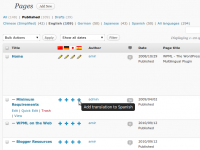With all the talk about reaching out to new communities and relevance, one might think that multilingual functionality on orchestra websites would be commonplace but unfortunately, the exact opposite is true. At the same, time, creating multiple language versions of online content has been a difficult, time consuming, and expensive task. Until Now.
The Google Option
 Over the past several years, Google has been steadily developing its translation services. They offer a host of options including a language toolkit, translation toolkit, and translation browser buttons. In fact, I used the basic online translation tool to come up with the title for today’s post. At the same time, automatic translation isn’t always perfect and none of the solutions actually provide a suitable solution for adding genuine multilingual versions of your website and its content.
Over the past several years, Google has been steadily developing its translation services. They offer a host of options including a language toolkit, translation toolkit, and translation browser buttons. In fact, I used the basic online translation tool to come up with the title for today’s post. At the same time, automatic translation isn’t always perfect and none of the solutions actually provide a suitable solution for adding genuine multilingual versions of your website and its content.
That’s where the difficult, time consuming, and expensive part typically kicks in. Actually setting up these pages without creating a standalone non-English version of your website is a resource gobbling task.
Open Source To The Rescue

Thankfully, if you rely on an open source based solution for your website (like The Venture Platform), you have some options that make creating the framework for multilingual content a snap. In particular, the system developed by wpml.org, a project developed by professional translation service ICanLocalize, is an option I use for Venture.
The system is remarkably easy and intuitive to use and once installed, creating and managing multilingual content is a snap. To translate a specific page of content, make sure the English version is all ready and a single click brings up a CMS admin panel that looks exactly like the English version, but in the new language you want to use. From there, you enter in the translated copy, save, and the system does the rest.
The system also provides an equally simple method for creating translated versions of navigation, sidebar menus, and other non standard page content. Site visitors can self select the language they want to use on the fly plus you can set the site up to land on a specific language version based on the origin of the visitor’s IP address. So forget the clumsy, outdated “select your language” landing page idea (which is a real traffic killer these days), this is far more fluid and keeps site visitors moving through content instead of creating bottlenecks through multilingual chokepoints.
One of Venture’s users is currently using the wpml.org solution and it has been a terrific solution (although we installed and set it up so quickly, they haven’t had time to complete and launch all of their translated content, so the site is still English only). In fact, it worked out so well that we decided to include it as a standard add-on so as to encourage as many users as possible to begin expanding their reach to non English speaking members of their community.
Turn Supporters Into Teams of Translators
Now that the technical hurdles are surmounted, there’s still the issue of translating the content. Open source solutions are terrific but they don’t actually provide a non-automated translation solution for your content. For that, you still need a real, live human being.
Sure, you can pay for professional translation services but those still have issues since much of the performing arts nomenclature can get lost in translation, so to speak. For that, it helps to have someone familiar with classical music and one of the first places to look for these experts is among your own supporters.
After all, we’re all looking for ways to get patrons and supporters involved, why not send out a call for translation assistance? The multilingual solution we offer for Venture actually has a built in translation management system that allows the organization to assign specific jobs to a variety of volunteer translators. The system even sends notification emails, provides a translation management screen, a jobs-queue and side-by-side translation editor, and your volunteers don’t have access to anything except the pages you assign and they can’t actually edit any of the original content nor can they publish the translated material.
Ultimately, I’ll be keeping a closer eye out for orchestra websites that provide multilingual versions of content in this year’s Orchestra Website Reviews (which are right around the corner) but in the meantime, do you know of any orchestra websites that do a good job with providing multilingual content?



The Hong Kong Phil. has a pretty decent bilingual site, and many if not most major European orchestras have at least some bilingual content; even if the auditions page frequently is only in the local language!
I really dislike being forced to use whatever language a website thinks I should be using based on my IP address. Yes, I have studied the language used where I live, but I will never be good enough at it to be able to read fluently. If you include IP detection to determine language selection, please include a button IN THE OTHER LANGUAGE(s) to allow the user to change languages. If, for example, an English speaker is presented with a Chinese page, and the button or link for changing to English is in Chinese, the English user may be stymied.
Barring a required landing page to select the language, I don’t believe there is any reasonable way to quickly get users into a site without the auto assign by IP address method. Of course, the wpml system provides the ability to put a convenient language switcher tabs/icons/buttons so going to a different language after landing is still faster than having to go through the required selector page.
So per your last point, which is entirely valid, the icon selector is what I’d recommend as it relies on flag images as opposed to text.
Granted, none of those solutions are perfect if you’re an ex-pat but having a system that will remember you upon subsequent visits and display the language you select is the easy way to get through that (and something wpml does).